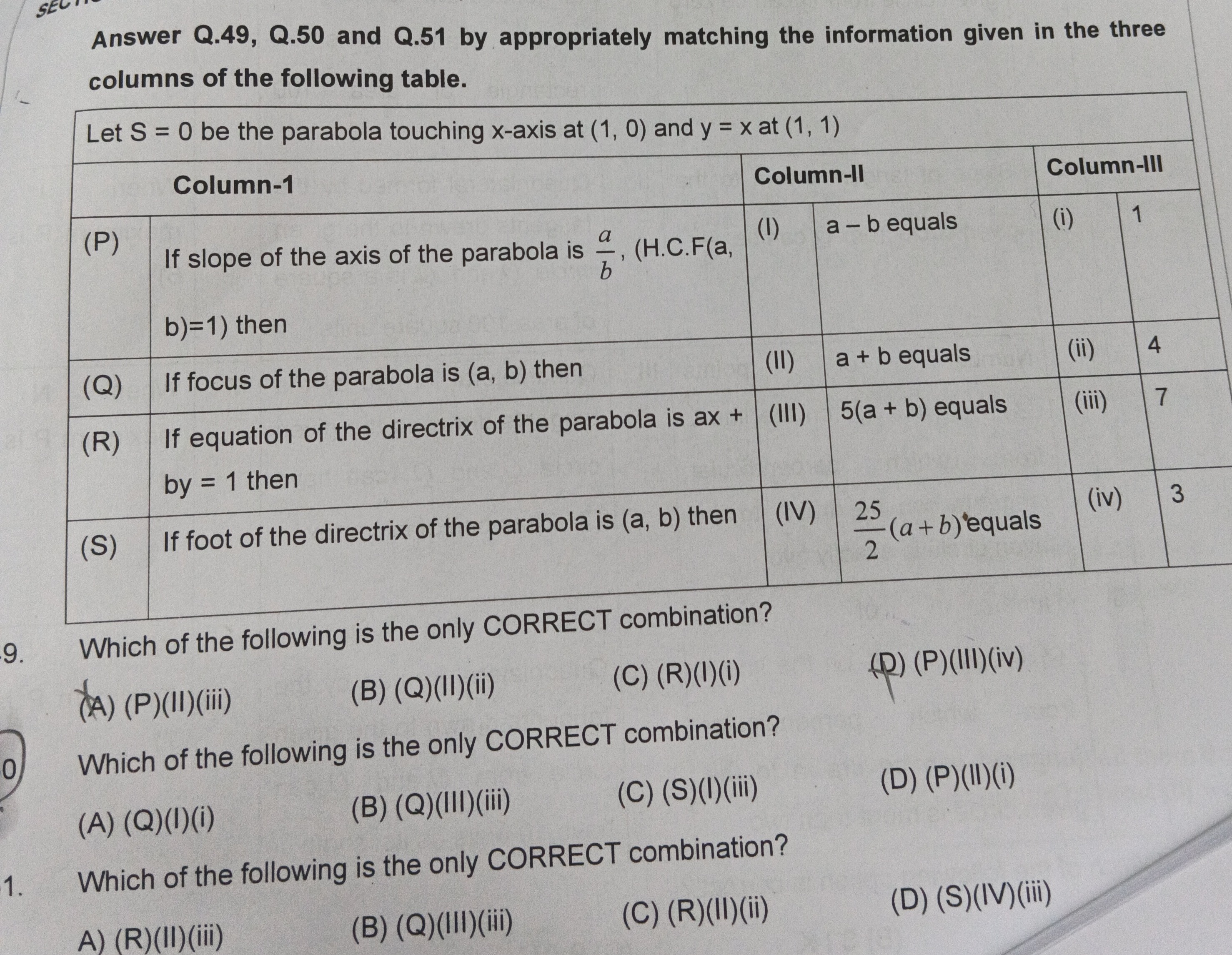Question
Question: Answer Q.49, Q.50 and Q.51 by appropriately matching the information given in the three columns of t...
Answer Q.49, Q.50 and Q.51 by appropriately matching the information given in the three columns of the following table.
Let S = 0 be the parabola touching x-axis at (1, 0) and y = x at (1, 1)
| Column-1 | Column-II | Column-III | |||
|---|---|---|---|---|---|
| (P) | If slope of the axis of the parabola is ba, (H.C.F(a, b)=1) then | (I) | a - b equals | (i) | 1 |
| (Q) | If focus of the parabola is (a, b) then | (II) | a + b equals | (ii) | 4 |
| (R) | If equation of the directrix of the parabola is ax + by = 1 then | (III) | 5(a + b) equals | (iii) | 7 |
| (S) | If foot of the directrix of the parabola is (a, b) then | (IV) | 225(a+b) equals | (iv) | 3 |
- Which of the following is the only CORRECT combination?

(P)(II)(iii)
(Q)(II)(ii)
(R)(I)(i)
(P)(III)(iv)
None of the options are correct.
Solution
-
Equation of the Parabola: The parabola touches the x-axis (L1:y=0) at (1, 0) and the line y=x (L2:x−y=0) at (1, 1). The chord of contact C passes through (1, 0) and (1, 1), so its equation is x=1 (C:x−1=0). The equation of the parabola is given by L1L2=λC2. y(x−y)=λ(x−1)2 xy−y2=λ(x2−2x+1) λx2−xy+y2−2λx+λ=0. For this to be a parabola, the condition h2=ab must be satisfied, where a=λ, b=1, h=−1/2. (−1/2)2=λ⋅1⟹λ=1/4. Substituting λ=1/4, the equation of the parabola is: 41x2−xy+y2−21x+41=0 Multiplying by 4: x2−4xy+4y2−2x+1=0.
-
Slope of the Axis (P): The line joining the point of intersection of the two tangents y=0 and x−y=0 (which is P(0,0)) to the midpoint of their chord of contact AB (which is M(21+1,20+1)=M(1,1/2)) is parallel to the axis of the parabola. The slope of the line PM is 1−01/2−0=1/2. Therefore, the slope of the axis of the parabola is 1/2. For (P), the slope is ba, where H.C.F(a, b)=1. So a=1,b=2. (P)(I) a−b=1−2=−1. (P)(II) a+b=1+2=3. (P)(III) 5(a+b)=5(3)=15. (P)(IV) 225(a+b)=225(3)=275.
-
Focus (Q) and Directrix (R) and Foot of Directrix (S): The equation of the parabola is x2−4xy+4y2−2x+1=0. This can be written as (x−2y)2=2x−1. Let the focus be (xf,yf) and the directrix be Ax+By+C=0. The equation of the parabola is (x−xf)2+(y−yf)2=A2+B2(Ax+By+C)2. By comparing coefficients with x2−4xy+4y2−2x+1=0, we find that the axis is x−2y−1=0. The directrix must be perpendicular to the axis, so its equation is 2x+y+d=0. The focus (xf,yf) lies on the axis x−2y−1=0, so xf=2yf+1. Let yf=k, so xf=2k+1. Substituting into the parabola equation: 5((x−(2k+1))2+(y−k)2)=(2x+y+d)2. 5(x2−2x(2k+1)+(2k+1)2+y2−2ky+k2)=4x2+y2+d2+4xy+4dx+2dy. x2+4y2−4xy−(2(2k+1)+4d)x−(2k+2d)y+(5((2k+1)2+k2)−d2)=0. Comparing with x2−4xy+4y2−2x+1=0: Coefficient of x: −(2(2k+1)+4d)=−2⟹4k+2+4d=2⟹4k+4d=0⟹k+d=0⟹d=−k. Coefficient of y: −(2k+2d)=0⟹2k+2d=0⟹k+d=0. (Consistent) Constant term: 5((2k+1)2+k2)−d2=1. 5(4k2+4k+1+k2)−(−k)2=1. 5(5k2+4k+1)−k2=1. 25k2+20k+5−k2=1. 24k2+20k+4=0. 6k2+5k+1=0. Factoring: (3k+1)(2k+1)=0. This gives two possible values for k: k=−1/3 or k=−1/2.
Case 1: k=−1/3 d=−k=1/3. Focus (a,b)=(2k+1,k)=(2(−1/3)+1,−1/3)=(1/3,−1/3). Directrix 2x+y+1/3=0⟹6x+3y+1=0. For ax+by=1, a=6,b=3. Foot of directrix: Intersection of axis x−2y−1=0 and directrix 6x+3y+1=0. Solving x=2y+1: 6(2y+1)+3y+1=0⟹12y+6+3y+1=0⟹15y=−7⟹y=−7/15. x=2(−7/15)+1=−14/15+1=1/15. Foot of directrix (a,b)=(1/15,−7/15).
Case 2: k=−1/2 d=−k=1/2. Focus (a,b)=(2k+1,k)=(2(−1/2)+1,−1/2)=(0,−1/2). Directrix 2x+y+1/2=0⟹4x+2y+1=0. For ax+by=1, a=4,b=2. Foot of directrix: Intersection of axis x−2y−1=0 and directrix 4x+2y+1=0. Solving x=2y+1: 4(2y+1)+2y+1=0⟹8y+4+2y+1=0⟹10y=−5⟹y=−1/2. x=2(−1/2)+1=−1+1=0. Foot of directrix (a,b)=(0,−1/2).
-
Evaluate Options:
Q.49: (A) (P)(II)(iii): (P) a+b=3. (iii) 7. 3=7. (Incorrect) (B) (Q)(II)(ii): (Q) a+b. (ii) 4. Case 1: 1/3+(−1/3)=0. Case 2: 0+(−1/2)=−1/2. Neither is 4. (Incorrect) (C) (R)(I)(i): (R) a−b. (i) 1. Case 1: 6−3=3. Case 2: 4−2=2. Neither is 1. (Incorrect) (D) (P)(III)(iv): (P) 5(a+b)=15. (iv) 3. 15=3. (Incorrect) Based on calculations, none of the options for Q.49 are correct.
